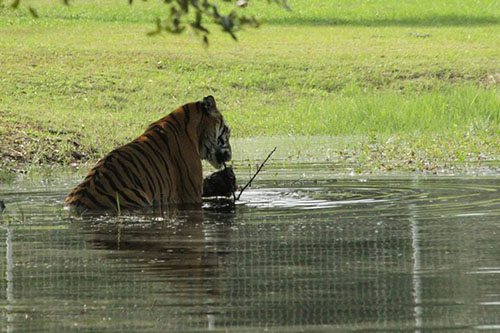Importing Generic Tigers
Importing Generic Tigers
Is it really illegal currently?

Rescinding the generic tiger loophole will stop the virtually unregulated inbreeding and cross breeding of tigers who are already in the U.S. because the breeder would have to submit an application showing how breeding the tiger would save tigers in the wild and thus serve some conservation value.
Most tigers are bred just to use the cubs until they are 12 weeks old and then they are discarded or warehoused. https://bigcatrescue.org/abuse-issues/issues/pet-cubs/
As I read through the current rule it looks as though you currently cannot import a generic tiger because it would serve no conservation value. If that rule were rescinded and generic tigers were treated the same as purebred tigers then one would have to apply for an import permit, but it appears that it would still be turned down because the generic tiger serves no conservation value.
The USFWS rubber stamps the circus moving tigers back and forth all the time and there is nothing about a circus that serves conservation value, so I’m wondering rescinding the generic tiger loophole would affect the rescue and import of generic tigers from awful situations in foreign countries where the tiger’s lineage is in question?
[Federal Register: August 12, 2010 (Volume 75, Number 155)]
[Proposed Rules]
[Page 48914-48919]
From the Federal Register Online via GPO Access [wais.access.gpo.gov]
[DOCID:fr12au10-21]
…International trade in tigers has been a source of concern to conservationists and species experts for many years. According to Inskipp and Wells (1979, p. 40), big cats already showed signs of becoming rare in the 1960s. Three tigers
[[Page 48917]]
were imported into the United States in 1968 (Jones 1970, p. 19). During 1968-1972, 17 living tigers were imported into the United States (McMahan 1986, p. 468). Following the ratification of CITES in the United States, during 1979-1980, a total of 103 live tigers were imported according to Service records. Overall, a total of 317 live Appendix I tigers were reported in international trade during 1979-1980 (McMahan 1986, p. 471).
More recently in the United States, more than 130 live tigers were either imported, exported, or re-exported legally during 2004-2006 (purpose of transaction: zoos, circuses and traveling exhibitions, and breeding in captivity; Service 2008c). About 6,000 illegally obtained items during that same time period were either abandoned at the port of entry or seized by U.S. law enforcement officials (primarily skins, teeth, trophies, and articles used for traditional medicine).
At the international level during 1976-1990, the average annual trade in tigers reported to CITES was about 16 individuals per year (primarily trophies; Nowell and Jackson 1996, p. 226). Elsewhere, reports about India (Environmental Investigation Agency 1998, 2006a, 2006b; Wright 2007) and Indonesia (Sumatra Island; Ng and Nemora 2007; Shepherd and Magnus 2004) document an ongoing illegal commercial and recreational trade in those countries. Wright (2007, p. 10) reported 34-81 tigers poached per year in India during 1998-2006. Poaching and killing tigers to protect livestock are also reported rangewide (Nowell and Jackson 1996, pp. 180-195).
Little is known about the nature or extent of disease in wild tiger populations. According to Nowell and Jackson (1996, p. 58), tiger mortality during the second year of life is 17 percent, while infanticide is overall the most common cause of cub death. Furthermore, Nowell and Jackson (1996, pp. 64-65) suggest that natural mortality is being replaced with mortality due to human activities.
Tigers can live up to about 15 years of age in the wild and up to 26 years of age in captivity (Nowell and Jackson 1996, p. 58). Habitat loss and reductions in the size of tiger prey populations increasingly are becoming significant determinants in tiger population sizes and geographic distribution. According to species experts, large tracts of contiguous habitat are essential to assure the survival of wild tigers on a long-term basis; small, isolated reserves cannot be relied upon to conserve the species (Nowell and Jackson 1996, p. 65).
Tigers readily breed in captivity and often are included in the exhibitions of larger zoos (Maz[aacute]k 1981, p. 6). The Leipzig Zoo has maintained the International Tiger Studbook since 1973 (M[uuml]ller 2004), while the AZA coordinates the Species Survival Plan Program (AZA 2008; Minnesota Zoo 2008). Species experts have recently proposed designs for landscape conservation efforts (Wikramanayake et al. 2004), as well as conservation and recovery priorities for wild tigers (Dinerstein et al. 2006; Sanderson et al. 2006).
There is a relatively large population of tigers in captivity. According to Werner (2005, p. 24), there are approximately 264 tigers in AZA-registered institutions in the United States, 1,179 in assorted wildlife sanctuaries, 2,120 in USDA-registered institutions, and 1,120 in private ownership (approximate U.S. total = 4,692 tigers).
An additional 5,000 tigers have been reported in captivity in China at sites popularly identified as tiger farms, with an annual production of 800 individuals (CITES 2007b, p. 4). The long-term status of these captive tigers, however, has been questioned by some as the Government of China is studying and assessing a suggestion to use the bones of captive specimens for domestic purposes in traditional Chinese medicine (CITES 2007c, p. 7; CITES 2007d, p. 7).
While domestic trade in tiger bone has been prohibited in China since 1993, traditional Chinese medicine–based in part on the use of tiger bones–continues (Shepherd and Magnus 2004; Nowell 2007; Ng and Nemora 2007). Fewer than 1,000 tigers occur in public zoos in Europe and Japan (Ron Tillson, cited by Morell 2007, p. 1312), while data for the quantity of tigers in private collections in Europe and Japan are not readily available.
The above was excerpted from a failed attempt by a backyard breeder to de-list the tiger as an Endangered Species.
https://www.fws.gov/policy/library/2010/2010-19895.html







